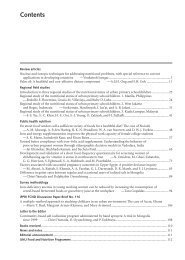From Invisible to Visible - Positive Deviance Initiative
From Invisible to Visible - Positive Deviance Initiative
From Invisible to Visible - Positive Deviance Initiative
You also want an ePaper? Increase the reach of your titles
YUMPU automatically turns print PDFs into web optimized ePapers that Google loves.
they were working <strong>to</strong>gether. “I’ve talked <strong>to</strong> large<br />
groups, I’ve talked <strong>to</strong> nurses, and made a tape on<br />
what this really costs, financially, physically, emotionally,”<br />
Ms. Lambeth says. She still works in the<br />
emergency department, and is adamant about<br />
hand hygiene and an ardent advocate for patient<br />
safety. She insists: “If you don’t wash your hands,<br />
don’t <strong>to</strong>uch a patient.”<br />
“What explains the recent drops in MRSA infections<br />
at Billings?” we ask Nick Wolter, the affable<br />
physician-CEO of Billings Clinic.<br />
“There are obviously many reasons,” Dr. Wolter<br />
notes. “However, the recent declines are less<br />
about implementing new technical solutions ….<br />
and more about improved interactions between<br />
people …. Infections are being prevented at<br />
Billings Clinic by changing relationships.”<br />
In the late nineteenth century, Émile<br />
Durkheim, xxiv the father of sociology, xxv argued that<br />
social phenomena (such as civic participation,<br />
protest and resistance, or neighborhood cohesion)<br />
arise when interactions between individuals<br />
create a reality that can no longer be accounted<br />
for by the attributes of individual ac<strong>to</strong>rs.<br />
The nature, scope, and quality of the relationship<br />
between interacting agents in a social system<br />
influence the degree of social order, stability, or<br />
health of a system. In that sense, MRSA infections<br />
can be viewed as a result of a deterioration<br />
in the quality of human interactions. If a patient,<br />
a family member, or physician assistant does not<br />
have the courage <strong>to</strong> tell a doc<strong>to</strong>r <strong>to</strong> wash hands<br />
before beginning an examination, and if physicians<br />
and other care-givers don’t do it, MRSA<br />
wins. However, if the relationship between them<br />
allows for such a conversation, then MRSA can be<br />
defeated. In this light, Nick Wolter’s statement<br />
about infections being “prevented by changing<br />
relationships” takes on a profound meaning.<br />
How have relationships changed at Billings Clinic<br />
since the PD MRSA initiative got underway in<br />
2006? Examples vary, but the consensus seems <strong>to</strong><br />
be “yes”. Ruth Senn, an LPN in inpatient surgical,<br />
says improvs increased conversations and empathy<br />
about the roles of others. She played an RN<br />
and a food service worker in different plays, and<br />
others who acted out other jobs echo her view.<br />
“There’s a PD atmosphere on our floor now,” Ms.<br />
Senn observes. “We interact as a team. We got the<br />
germ buster of the month award.”<br />
Ms. Harakal, the ICU manager, said ICU nurses<br />
have always had close working relationships with<br />
ICU physicians. “Once our intensivists were on<br />
board they were able <strong>to</strong> influence other groups.”<br />
Ms. Block, the ICU clinical coordina<strong>to</strong>r, says the<br />
work has generated increased bonding and camaraderie.<br />
“With MRSA, there’s always a s<strong>to</strong>ry,” she<br />
observed. “And for every s<strong>to</strong>ry you think of, there<br />
are five or six more. When you can have s<strong>to</strong>ries<br />
and a face with a situation, it emphasizes the<br />
importance, and it sinks in and becomes a lot<br />
more personal.”<br />
Social network maps xxvi can provide insights on<br />
how changing human relationships can contribute<br />
<strong>to</strong> MRSA prevention and control. June<br />
Holley, an expert in social network analysis, prepared<br />
network maps <strong>to</strong> understand the shift in<br />
relationships at Billings Clinic. By surveying some<br />
300-plus employees involved in MRSA prevention<br />
work and plotting their shifting patterns of<br />
interaction over time, Holley demonstrated that<br />
connectivity increased significantly both between<br />
and among the various hospital units: More people<br />
were having more conversations about MRSA<br />
prevention and control within and across units,<br />
and more cross-unit collaborations were occurring<br />
<strong>to</strong> rope in MRSA.<br />
23

















